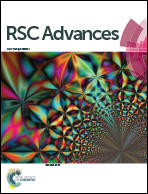Energy transfer and multicolor emission in single-phase Na5Ln(WO4)4−z(MoO4)z:Tb3+,Eu3+ (Ln = La, Y, Gd) phosphors†
Abstract
A series of Tb3+ and/or Eu3+-doped Na5Ln(WO4)4−z(MoO4)z (0 ≤ z ≤ 4, Ln = La, Y, Gd) phosphors have been prepared via a simple Pechini method. X-ray diffraction (XRD) profile analyses have verified the formation of a single phase with scheelite-like structure. The scheelite-like tetragonal structure provides the Na5Ln(WO4)4 hosts the possibility of doping with Tb3+/Eu3+ ions without substantial luminescence quenching. Under near UV light excitation, Tb3+ and Eu3+-doped Na5Ln(WO4)4 phosphors exhibit characteristic emissions of Tb3+ (5D3,4 → 7FJ) and Eu3+ (5D0 → 7FJ), respectively. By codoping the Tb3+ and Eu3+ ions into the Na5Ln(WO4)4 host and tuning their relative concentration ratio, multicolor tunable emissions are obtained by varying the ratio of Tb3+/Eu3+. The energy transfer from Tb3+ to Eu3+ in Na5Ln(WO4)4 has been investigated by photoluminescence and decay measurements. The influence of W substitution by Mo on the luminescence properties of Na5Ln(WO4)4−z(MoO4)z:Tb3+/Eu3+ has also been investigated. Both the emission intensities of Tb3+ and Eu3+ ions were found to reach a maximum when the molar ratio of W/Mo was 2 : 2. The results suggest that Na5Ln(WO4)4−z(MoO4)z:Tb3+/Eu3+ phosphors might find potential applications in the field of solid state lighting and field emission displays.


 Please wait while we load your content...
Please wait while we load your content...